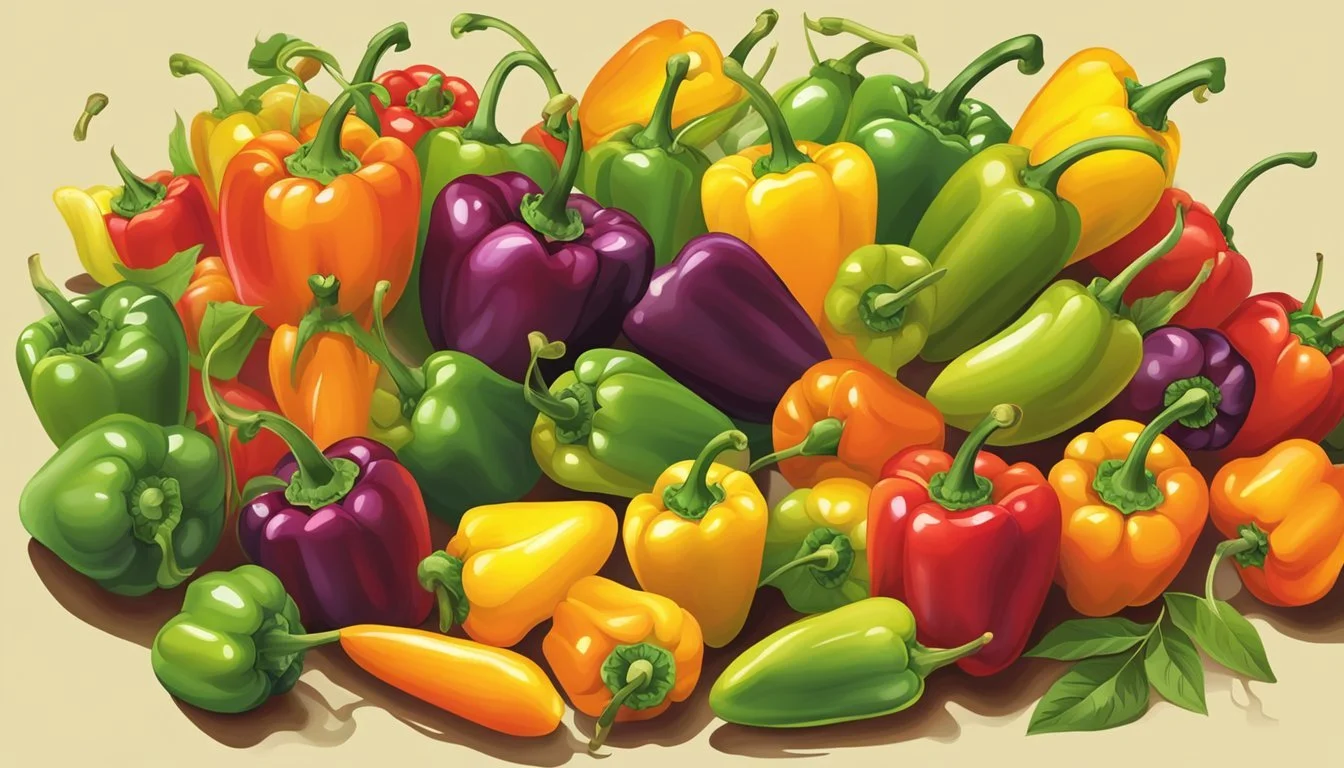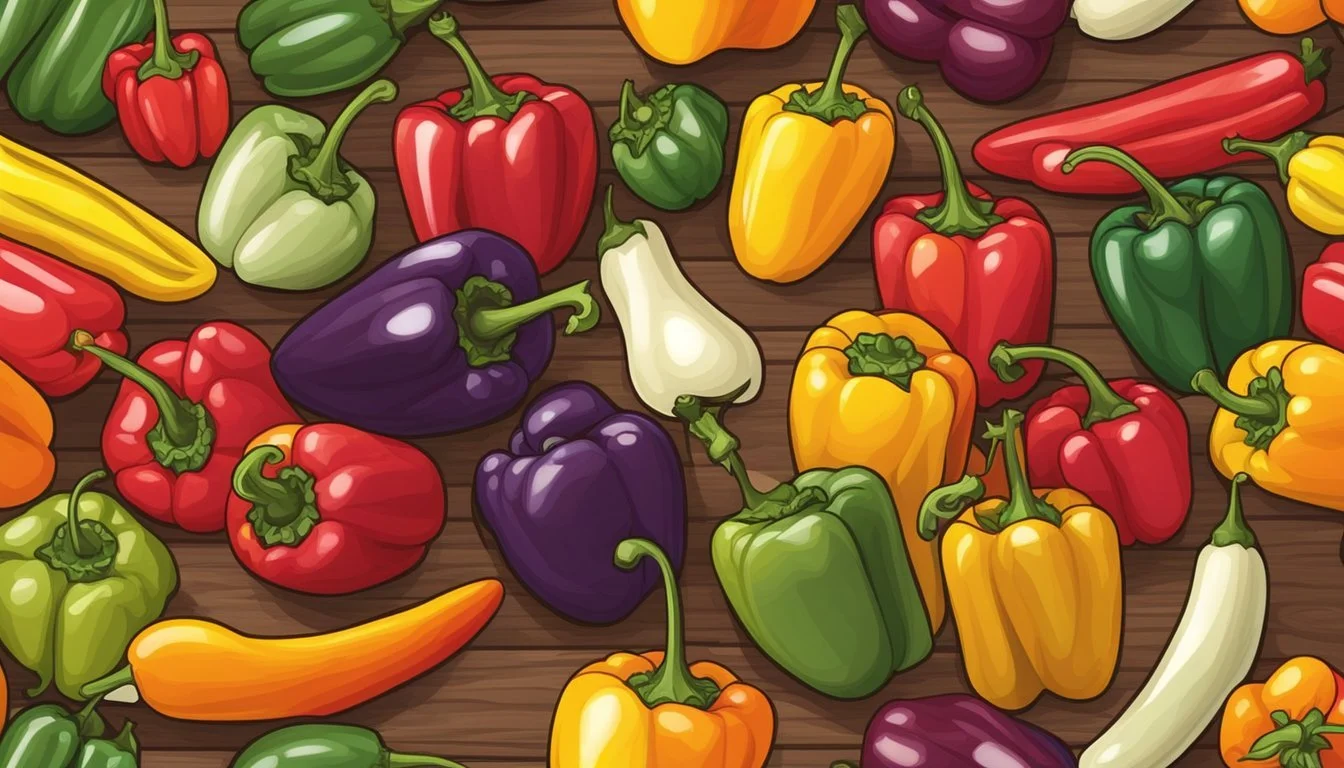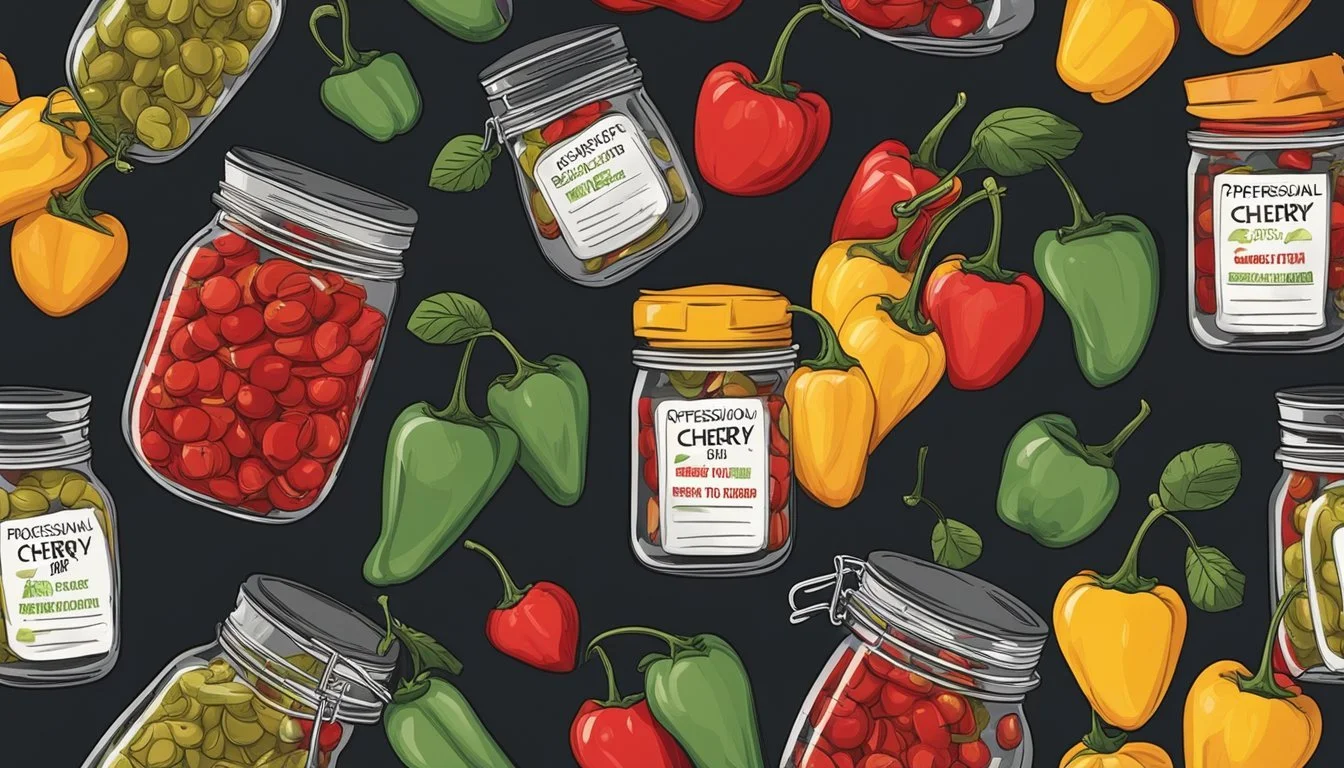Cherry Peppers Substitutes
Best Alternatives for Your Recipes
When you're in the middle of preparing a recipe that calls for cherry peppers and you realize you're out, finding the right substitute becomes essential. One effective substitute for cherry peppers is the Rocoto chili, known for its sweet and citrusy flavors coupled with extreme spiciness. Rocoto chiles not only mimic the heat of cherry peppers but also bring a unique taste to your dish.
Another viable option is the jalapeño pepper, which offers a slightly higher heat level compared to cherry peppers. Jalapeños are a common ingredient that can easily replace cherry peppers in most recipes, providing that necessary kick. For those looking for a milder and sweeter alternative, sweet cherry peppers can do the trick, though they lack the spiciness of hot cherry peppers.
Understanding these substitutes ensures you can continue cooking without compromising the flavor profile of your dish. Exploring these options enables a seamless culinary experience, regardless of what ingredients are missing from your pantry.
Understanding Cherry Peppers
Cherry peppers, known for their small, round shape and vibrant colors, bring a unique combination of sweetness and spiciness to various dishes. These peppers are not only visually appealing but also versatile in culinary applications and packed with essential nutrients.
Characteristics of Cherry Peppers
Cherry peppers, also known as pimiento peppers, are small and round, resembling cherries in both size and shape. They come in colors such as red and green, and sometimes yellow.
The texture is juicy and crisp, which makes them a delightful addition to many recipes. In terms of spiciness, cherry peppers have a Scoville heat rating between 2,500 and 5,000 SHU. This places them in the mild to medium heat range.
Cherry peppers can be sweet or hot, offering a range of flavors from tangy and fruity to slightly spicy. Their distinct taste makes them a favorite in many kitchens.
Culinary Uses of Cherry Peppers
Cherry peppers are incredibly versatile in the kitchen. They can be pickled, stuffed with cheese or meats, or used as garnishes. Pickled cherry peppers are common in antipasto platters and add a tangy zest to sandwiches.
Stuffed cherry peppers, often filled with soft cheese, make for delightful appetizers. They can also be chopped and added to salads for an extra crunch and flavor.
In cooked dishes, they add sweetness and a mild heat, making them suitable for a variety of culinary applications, from pizzas to pastas.
Nutritional Profile of Cherry Peppers
Cherry peppers are not just flavorful but also packed with nutrients. They are a good source of vitamin C, which is essential for the immune system and skin health. A single serving can provide a significant portion of the daily recommended intake of vitamin C.
In addition to vitamin C, cherry peppers contain vitamin A, vitamin E, and various antioxidants. These nutrients contribute to overall health and well-being.
They are low in calories, making them a healthy addition to any diet. The nutritional benefits, combined with their unique taste and versatility, make cherry peppers a valuable ingredient in healthy eating.
Selecting Cherry Pepper Substitutes
When you're out of cherry peppers, finding a fitting substitute involves considering aspects like flavor, heat level, and texture. Some common substitutes boast similar profiles, ensuring your dishes retain their intended taste and appearance.
Criteria for Choosing Substitutes
Flavor Profile: The substitute should ideally have a similar balance of sweetness and heat to cherry peppers. Pickled pepperoncini and pimento peppers offer comparable sweetness with mild heat, making them good options for maintaining the flavor integrity of dishes.
Texture and Appearance: Choose substitutes that mimic the firm, crisp texture and bright appearance of cherry peppers. Pickled jalapeños provide a good crunchy texture, while red bell peppers can match the vibrant color when used in salads or garnishes.
Usage in Cooking: Consider how the substitute will perform in various cooking methods. Serrano peppers can be used for stuffing, while pimentos are great for sauces or as toppings due to their rich flavor. Evaluating how the substitute complements the dish helps in maintaining culinary harmony.
Popular Cherry Pepper Alternatives
There are several substitutes for cherry peppers that can be used in various recipes. Each of these alternatives brings its own unique flavor and texture, making them suitable for different culinary applications.
Peppadew Peppers
Peppadew peppers have a sweet, tangy flavor with mild heat, making them an excellent substitute for cherry peppers. Originating from South Africa, they are often sold pickled and can be used in sauces, salsas, or as a garnish.
They are particularly popular in stuffed dishes, often filled with cheese or meat. Peppadew peppers bring a burst of flavor and a slight crunch, ideal for adding complexity to sandwiches and salads. Their bright red color also adds visual appeal to any dish.
Pimientos
Pimientos, or pimentos, are another great alternative. These peppers are sweeter and milder compared to cherry peppers, making them suitable for those who prefer less heat. Pimientos are commonly found in stuffed olives or used in pimento cheese.
They can be added to a variety of dishes such as salads, sandwiches, and sauces. Due to their mild flavor, pimientos can balance out spicier ingredients, ensuring a harmonious taste profile. They are also used in stuffing recipes, providing a sweet and savory component.
Red Bell Peppers
Red bell peppers are versatile and easily accessible substitutes for cherry peppers. While they lack the heat, their sweet and crisp nature makes them ideal for stuffing, grilling, or using fresh in salads and salsas.
Cut into strips or diced, red bell peppers can be included in stir-fries, sandwiches, and sauces. They are an excellent choice for anyone looking to add a pop of color and sweetness without the spiciness. Their thick flesh holds up well in cooked dishes, making them a reliable ingredient in many recipes.
Spicier Substitutes for Cherry Peppers
For those seeking more heat, certain chili peppers and red pepper flakes can elevate your dishes with greater intensity. These substitutes provide a significant increase in spiciness, making them ideal for recipes that need an extra kick.
Chili Peppers
Chili peppers such as jalapeños, serrano peppers, and cayenne peppers are excellent spicier substitutes for cherry peppers.
Jalapeños: These peppers rate between 2,500 and 8,000 on the Scoville scale. They offer a moderate increase in spiciness with a slightly grassy flavor.
Serrano Peppers: With a rating of 10,000 to 23,000 Scoville heat units, serrano peppers are significantly hotter than cherry peppers. They provide a sharper heat and bright flavor.
Cayenne Peppers: These pack a punch at 30,000 to 50,000 Scoville heat units. Cayenne pepper is particularly useful in powder form and adds a fiery kick to dishes.
Red Pepper Flakes
Red pepper flakes consist of crushed, dried chili peppers and are another potent substitute.
Capsaicin Content: These flakes are rich in capsaicin, the compound responsible for their heat, and can range from 15,000 to 45,000 Scoville heat units.
Usage: Red pepper flakes can be sprinkled directly onto dishes for a spicy boost or incorporated into sauces and marinades to evenly distribute their heat.
Using either chili peppers or red pepper flakes will ensure your dishes have the desired spicy flavor that cherry peppers might lack.
Milder Substitutes with Distinct Flavors
For those who prefer a milder yet flavorful substitute for cherry peppers, there are several options available. Each of these substitutes offers unique tastes and textures that can enhance various culinary dishes.
Anaheim and Poblano Peppers
Anaheim peppers are long, green, and mildly spicy, scoring between 500 to 2,500 Scoville Heat Units (SHU). Their subtle heat and slightly sweet flavor make them a versatile option in many recipes. Anaheim peppers are especially great for roasting, stuffing, or adding to salsas and salads.
Poblano peppers, with a heat rating of 1,000 to 2,000 SHU, are another mild choice. These dark green peppers turn red or brown when fully ripe. Poblano peppers are well-known for their rich, earthy flavor and are commonly used in Mexican dishes such as chiles rellenos.
Cubanelle and Sweet Red Peppers
Cubanelle peppers are noted for their light green color and elongated shape. Their mild heat and slightly sweet, fruity flavor provide a perfect balance, making them excellent for frying, stuffing, or adding raw to salads. They typically range between 100 to 1,000 SHU, ensuring a gentle spiciness.
Sweet red peppers, although not spicy, offer a sweet, crisp texture that's ideal for a variety of culinary uses. Often referred to as red bell peppers, they work well in both raw and cooked applications, brightening dishes with their vivid color and sweet flavor. They are an excellent choice for those looking to avoid spiciness altogether.
By using these substitutes, one can achieve the desired flavor profile while accommodating a preference for milder spiciness.
Using Pepper Substitutes in Recipes
When using pepper substitutes in recipes, it's important to account for both texture and flavor as well as heat levels to ensure the final dish meets your expectations.
Adjusting for Texture and Flavor
Different substitutes bring their own textures and flavors to dishes. For instance, sweet red peppers add a mild heat and crunchy texture to salads and sandwiches. When making stuffed peppers, pimentos can be an excellent choice as they mimic the sweet flavor of cherry peppers.
In cooked dishes like casseroles or stir-fries, using roasted red peppers can add a tender texture with a smoky undertone. For relishes and salsas, pickled jalapenos offer a tangy and slightly spicy profile that complements nachos and pizza toppings.
Pro tip: When substituting for garnishes, using rocoto chiles can introduce a citrusy and sweet flavor that pairs well with egg dishes and baked potatoes.
Considerations for Heat Levels
Understanding the heat level of your substitute is crucial. Jalapenos provide a similar spiciness to hot cherry peppers, making them suitable for cheesesteaks or pizza toppings. For those preferring a milder heat, sweet cherry peppers or pepperoncini can offer similar flavors without overwhelming spiciness.
In spicy dishes like salsas or stir-fries, chipotle powder can introduce a smoky heat that enhances the dish's depth. When cooking milder dishes, such as salads or casseroles, sweet red peppers serve as an excellent substitute with minimal heat impact.
Pro tip: Rocoto chiles are extremely spicy and should be used sparingly in recipes that call for high heat, such as in certain spicy relishes or boiled dishes.
By thoughtfully selecting and adjusting for texture, flavor, and heat levels, one can navigate the variety of pepper substitutes effectively to elevate any culinary creation.
Non-Pepper Alternatives
When cherry peppers are not available, there are several non-pepper substitutes that can be used to achieve similar flavors and textures. Substitutes range from vegetables and fruits to various condiments and spices.
Substituting with Vegetables and Fruits
Cherry tomatoes can serve as an excellent substitute for cherry peppers. They have a sweet and slightly tart flavor that can complement many dishes. They can be used fresh in salads, as a topping on pizzas, or even pickled to add zest to sandwiches.
Olives are another great alternative. Their briny taste works well in many recipes where cherry peppers are used. Green or black olives can be added to salads, pasta dishes, and as a garnish on various appetizers.
Pickled vegetables like giardiniera, which often includes carrots, celery, and cauliflower, provide a tangy and crunchy option. They can be used in sandwiches and as a topping on pizzas or hot dogs, offering a similar pickled flavor to cherry peppers.
Using Condiments and Spices
Pickled jalapenos can be used in place of cherry peppers when a bit of heat is desired. They are readily available and can add a spicy, tangy kick to dishes such as nachos, tacos, and burgers.
Vinegar-based sauces with garlic or black pepper can also replicate the tanginess of cherry peppers. These can be drizzled over roasted vegetables, used as a marinade for meats, or mixed into dressings.
Spices like black pepper and garlic powder can be combined for a similar effect in recipes that call for the heat and earthiness of cherry peppers. Adding a bit of sugar or honey can balance the flavors when using these spices in sauces or marinades.
Preservation Methods for Substitutes
Substitutes for cherry peppers can be preserved effectively through pickling and marinating or canning and storing. These methods help maintain their flavor and texture for extended periods.
Pickling and Marinating
Pickling substitutes such as rocoto chiles or Scotch bonnets can enhance their flavor while extending their shelf life. Pickled forms of these peppers can include combinations with garlic, onions, and celery to create a robust and tangy mix.
Giardiniera is a popular pickled vegetable mix that can incorporate these substitutes. When pickling, using a mixture of vinegar, water, and salt helps maintain the peppers’ spiciness and crunch.
Marinating substitutes such as rocoto chiles with cream cheese or adding to a garlic, and onion marinade can create flavorful additions ready for quick use in recipes.
Canning and Storing
Canning is another effective method to preserve pepper substitutes. It involves sealing the peppers in jars and heating them to kill any microorganisms. The canning process helps retain the substitutes’ color and flavor for months.
Blanching substitutes like hot cherry peppers before canning them ensures their texture remains intact. When preparing for long-term storage, consider combining peppers with onions and celery to add depth to the final product.
Proper labeling of the jars with the canning date helps in tracking the freshness of the preserved substitutes. Keep the canned jars in a cool, dark place away from direct sunlight.








